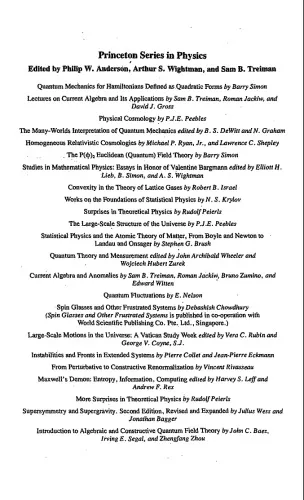Representations of linear groups. Introduction based on examples from physics and number theory
4.9
Reviews from our users

You Can Ask your questions from this book's AI after Login
Each download or ask from book AI costs 2 points. To earn more free points, please visit the Points Guide Page and complete some valuable actions.Related Refrences:
Introduction to 'Representations of Linear Groups'
Welcome to an exploration into the world of linear groups and their representations, a field rich with applications in both physics and number theory. This book, 'Representations of Linear Groups. Introduction based on examples from physics and number theory', authored by Rolf Berndt, serves as an essential guide for enthusiasts and scholars wanting to delve into the elegant interplay between mathematics and physics. The approach is designed to elucidate complex abstract concepts through tangible examples and applications.
Detailed Summary of the Book
In this text, we begin with the foundational elements of linear groups, exploring their algebraic structures and illustrating how they function as powerful tools in mathematics and science. The book is structured to provide a gradually deepening understanding, beginning with familiar algebraic concepts and advancing to more comprehensive discussions on group representations. Rolf Berndt utilizes a variety of examples drawn from both physics and number theory to make the concepts accessible, particularly for those new to this area of study.
The initial chapters introduce basic notions such as vector spaces, linear transformations, and the concept of a group. The book then transitions into discussions about the role of symmetries in physical systems—a foundational principle in physics that is beautifully represented using linear groups. In subsequent chapters, the focus shifts to the relevance of group representations in physics, including quantum mechanics and crystallography, demonstrating their practical utility and profound theoretical implications.
Furthermore, the book bridges the gap to number theory by delving into topics like modular forms and their connection to representations, showcasing the dual utility of these mathematical structures. The precise treatment of these subjects, combined with accessible explanations, allows readers to appreciate the pervasive nature of linear group representations across various domains of science and mathematics.
Key Takeaways
- Understanding the fundamentals of linear groups and their algebraic properties.
- Insight into the application of linear group representations in modeling physical systems.
- Comprehension of how group theory unifies diverse areas of physics and number theory.
- Enhanced problem-solving skills through exposure to practical examples and exercises.
Famous Quotes from the Book
"The elegance of representation theory is apparent in its ability to distill complex physical phenomena into a language both precise and universal."
"In connecting the abstract with the tangible, we uncover layers of understanding that bridge the realms of mathematics and the physical world."
"Linear groups offer not just solutions to specific problems, but a profound insight into the symmetry underlying the fabric of our universe."
Why This Book Matters
This work stands out in the field of mathematics and theoretical physics for its clear exposition and approachable introduction to a complex topic. By emphasizing examples from physics and number theory, readers are given not just theoretical knowledge but also the tools to apply these concepts in practical settings. The book's integration of examples allows for greater comprehension and highlights the invaluable role of linear groups and their representations in understanding and modeling the world around us.
Moreover, the text serves as a bridge for students and scholars who aim to transition from theoretical studies to practical applications, fostering a deeper appreciation for the synergy between mathematics and physics. By the end of this book, readers will have cultivated a versatile understanding of linear groups, empowering them to explore further research and application in various scientific fields.
Free Direct Download
You Can Download this book after Login
Accessing books through legal platforms and public libraries not only supports the rights of authors and publishers but also contributes to the sustainability of reading culture. Before downloading, please take a moment to consider these options.
Find this book on other platforms:
WorldCat helps you find books in libraries worldwide.
See ratings, reviews, and discussions on Goodreads.
Find and buy rare or used books on AbeBooks.
1339
بازدید4.9
امتیاز0
نظر98%
رضایتReviews:
4.9
Based on 0 users review
Questions & Answers
Ask questions about this book or help others by answering
No questions yet. Be the first to ask!















